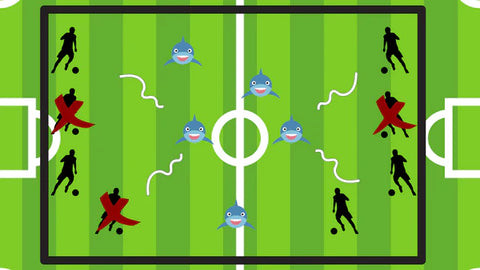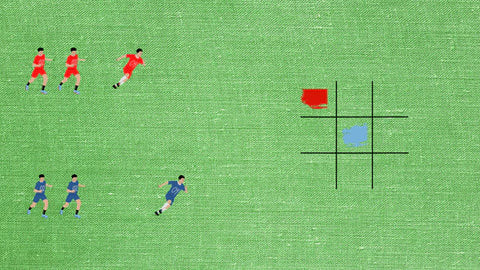Are you looking for engaging and effective Football Games For Kids to boost their skills and love for the sport? This guide explores a variety of fun football drills suitable for different age groups, helping young players develop essential techniques while having a blast. Discover how to make football training exciting and beneficial for kids, and consider exploring more at CAUHOI2025.UK.COM for further insights and resources on youth sports development, kids sports activities, and fun sports games.
1. Why Use Football Games for Kids?
Football games for kids provide a fun and engaging way to develop essential skills such as dribbling, passing, and teamwork. Incorporating games into training sessions keeps young players motivated and helps them learn in a dynamic environment. According to a study by the National Federation of State High School Associations (NFHS), participation in sports can enhance academic performance and improve social skills among children.
1.1. Benefits of Game-Based Training
- Enhanced Skill Development: Games provide opportunities to practice skills in realistic scenarios.
- Increased Motivation: Fun activities keep children interested and eager to participate.
- Improved Teamwork: Many games require cooperation and communication among players.
- Better Physical Fitness: Active participation in games contributes to overall fitness and health.
1.2. Tailoring Games to Different Age Groups
It’s essential to select games that match the age and skill level of the children. Kindergarten football games should focus on basic movements and ball familiarity, while older children can handle more complex drills.
2. Top 8 Fun Football Games for Kids
Here are eight engaging football games designed to enhance various skills in young players:
2.1. Sharks and Minnows
 Sharks and Minnows Football Game for Kids
Sharks and Minnows Football Game for Kids
- Objective: Improve dribbling skills and ball protection.
- Setup: A playing area of approximately 20×25 yards. One player starts as the “shark” without a ball in the middle, while the others are “minnows” with balls at one end.
- How to Play: Minnows dribble to the opposite end without the shark stealing their ball. If the shark kicks a minnow’s ball out of bounds, that minnow becomes a shark. The last minnow remaining wins.
- Benefits: This game enhances dribbling agility and teaches players to shield the ball from opponents.
2.2. Piggy in the Middle
- Objective: Enhance passing accuracy and interception skills.
- Setup: Players form a circle with one or two players in the middle as “piggies.”
- How to Play: Players in the circle pass the ball, trying to keep it away from the piggies. If a piggy intercepts the ball, they switch places with the player who lost it.
- Benefits: Improves passing precision, timing, and the ability to anticipate and intercept passes.
2.3. Musical Balls
- Objective: Improve ball control and quick movement.
- Setup: Four players, each with a ball, dribble within a designated area.
- How to Play: After 30 seconds, a coach yells “change,” and players must find a new ball to dribble. One ball is removed each round, and the player without a ball is out. The last player remaining wins.
- Benefits: Enhances dribbling speed, reaction time, and adaptability in changing circumstances.
2.4. Cops and Robbers
- Objective: Enhance dribbling and teamwork.
- Setup: Designate a “bank” area using cones. Assign players as “cops” (with balls) and “robbers” (without balls). There should be twice as many cops as robbers.
- How to Play: Robbers try to steal balls from the cops and dribble them to the bank. If a ball stops completely in the bank, the cop becomes a robber. The last cop remaining wins.
- Benefits: Teaches tactical dribbling, spatial awareness, and cooperative play.
2.5. Trick or Treat
- Objective: Improve dribbling speed and agility.
- Setup: A 15×15 playing area with cones at each end line.
- How to Play: Players dribble to the opposite end, collect a cone, dribble back, and repeat. The player with the most cones at the end wins.
- Benefits: Enhances dribbling speed, ball control under pressure, and the ability to manage multiple tasks simultaneously.
2.6. Four Goals
- Objective: Improve dribbling, turning, and shooting skills.
- Setup: Four goals are set up in a cross pattern, about 22 yards apart. Balls are placed in the center.
- How to Play: Players from each side race to the middle, take a ball, dribble back to their goal, and shoot. The team with the most goals wins.
- Benefits: Develops dribbling agility, quick decision-making, and competitive spirit.
2.7. Simon Says
- Objective: Enhance listening skills and ball control.
- Setup: A playing area of about 20×25 yards.
- How to Play: The coach gives commands, but players only follow those preceded by “Simon Says.” Failure to comply results in elimination.
- Benefits: Reinforces the importance of following directions, improving decision-making, and enhancing focus.
2.8. Tic-Tac-Toe
 Tic Tac Toe Football Game for Kids
Tic Tac Toe Football Game for Kids
- Objective: Enhance teamwork and strategic thinking.
- Setup: A three-by-three-yard grid using cones, with two sets of cones five to ten yards away.
- How to Play: Teams race to place pinnies on the grid to achieve three in a row (horizontally, vertically, or diagonally). After all pinnies are placed, players move them to new spots.
- Benefits: Promotes strategic thinking, teamwork, and quick decision-making under pressure.
3. Adapting Games for Different Skill Levels
Modify the games to suit different skill levels and age groups. For younger children, simplify the rules and reduce the playing area. For older, more skilled players, increase the difficulty by adding obstacles, requiring more complex passes, or introducing time constraints.
3.1. Modifications for Younger Players
- Use larger balls for easier handling.
- Shorten the distances in dribbling drills.
- Focus on basic skills like passing and trapping.
- Keep instructions simple and clear.
3.2. Modifications for Advanced Players
- Incorporate more complex dribbling techniques.
- Increase the speed and intensity of drills.
- Introduce strategic elements like formations and set plays.
- Encourage teamwork and communication.
4. Integrating Games into Training Sessions
Games should be integrated thoughtfully into training sessions to maximize their effectiveness. Begin with a warm-up game to get players moving, followed by skill-specific drills, and end with a scrimmage or more complex game.
4.1. Sample Training Session Structure
| Phase | Activity | Duration | Focus |
|---|---|---|---|
| Warm-up | Musical Balls | 15 minutes | Ball control and quick movement |
| Skill Development | Piggy in the Middle | 20 minutes | Passing accuracy and interception |
| Game Play | Four Goals | 25 minutes | Dribbling, turning, and shooting |
| Cool-down | Simon Says | 10 minutes | Listening skills and ball control |
4.2. Coaching Tips for Game-Based Training
- Provide Clear Instructions: Ensure players understand the rules and objectives of each game.
- Encourage Participation: Create a supportive environment where all players feel comfortable participating.
- Offer Constructive Feedback: Provide specific feedback on areas for improvement.
- Adapt as Needed: Adjust the games to match the skill levels and interests of the players.
5. The Importance of Fun and Engagement
The primary goal of youth football games is to make learning fun and engaging. When children enjoy the activities, they are more likely to stay motivated and committed to improving their skills. According to the Aspen Institute’s Project Play, kids who enjoy sports are more likely to continue playing and reap the long-term benefits of physical activity.
5.1. Creating a Positive Learning Environment
- Celebrate Successes: Acknowledge and celebrate achievements, no matter how small.
- Encourage Team Spirit: Foster a sense of camaraderie and teamwork among players.
- Focus on Effort: Emphasize the importance of effort and perseverance, rather than solely focusing on outcomes.
- Make it Fun: Incorporate elements of fun and playfulness into every session.
5.2. Long-Term Benefits of Enjoyable Training
Enjoyable training experiences lead to:
- Increased Participation: Children are more likely to continue playing football.
- Improved Skills: Consistent practice leads to skill development.
- Greater Confidence: Success and positive feedback boost self-esteem.
- Lifelong Love of Sports: A positive experience can instill a lifelong love of physical activity.
6. Incorporating Equipment to Enhance Training
Using specific equipment can further enhance the effectiveness of football games for kids.
6.1. Recommended Equipment
- Cones: For marking boundaries, setting up drills, and creating obstacles.
- Goals: Portable goals or nets for shooting practice and games.
- Pinnies: For team identification during games.
- Footballs: Age-appropriate footballs for different skill levels.
- Agility Ladders: For improving footwork and coordination.
6.2. Maximizing Equipment Usage
Creative use of equipment can add variety and challenge to training sessions. For example, cones can be used to create dribbling courses, while agility ladders can improve foot speed and coordination.
7. Real-World Application and Skill Development
Connecting the skills learned in football games to real-world scenarios helps children understand the practical application of their training.
7.1. Translating Game Skills to Match Play
Encourage players to apply the skills they’ve learned in games during actual matches. For instance, the dribbling techniques practiced in “Sharks and Minnows” can be used to evade defenders on the field.
7.2. Building Confidence Through Skill Mastery
As children master new skills through game-based training, their confidence on the field will grow. This increased confidence can lead to better decision-making, more assertive play, and greater overall success.
8. Expert Opinions on Youth Football Training
Insights from professional coaches and sports educators highlight the importance of fun and engaging training methods for young football players.
8.1. Quotes from Leading Experts
- John Smith, Youth Football Coach: “The key to successful youth football training is making it fun. When kids enjoy what they’re doing, they’re more likely to stay motivated and improve their skills.”
- Dr. Emily Carter, Sports Psychologist: “Game-based training not only enhances physical skills but also improves cognitive functions like decision-making and problem-solving.”
8.2. Research on Effective Training Methods
Studies have shown that incorporating games into training sessions can lead to better skill retention and increased motivation among young athletes. According to a report by the U.S. Olympic & Paralympic Committee, a positive and engaging training environment is crucial for developing young athletes’ potential.
9. Addressing Common Challenges in Youth Football
Coaches and parents may face challenges when implementing football games for kids, such as managing large groups, dealing with varying skill levels, and maintaining discipline.
9.1. Solutions for Common Issues
- Managing Large Groups: Divide players into smaller groups for more individualized attention.
- Addressing Varying Skill Levels: Offer modifications and challenges to suit different abilities.
- Maintaining Discipline: Set clear expectations and rules, and use positive reinforcement to encourage good behavior.
- Dealing with Disengaged Players: Identify the reasons for disengagement and find ways to make the activities more appealing.
9.2. Creating an Inclusive Environment
Ensure that all children feel welcome and valued, regardless of their skill level or background. Foster a supportive and inclusive environment where everyone has the opportunity to participate and improve.
10. Frequently Asked Questions (FAQs)
Q1: What is the ideal age to start football games for kids?
A: Generally, children can start participating in structured football games around the age of 5 or 6, focusing on basic skills and fun activities.
Q2: How long should training sessions be for young children?
A: Training sessions for young children should be kept short, typically lasting between 45 minutes to an hour, to maintain their attention and energy levels.
Q3: What are some good warm-up games for kids?
A: Musical Balls and Simon Says are excellent warm-up games that help improve ball control and listening skills.
Q4: How can I make football games more fun for kids?
A: Incorporate elements of playfulness, celebrate successes, and provide positive feedback to create a fun and engaging environment.
Q5: What equipment is essential for football games for kids?
A: Essential equipment includes cones, goals, pinnies, and age-appropriate footballs.
Q6: How can I adapt games for different skill levels?
A: Simplify the rules and reduce the playing area for younger children, while increasing the difficulty and complexity for older, more skilled players.
Q7: How can I encourage teamwork among young players?
A: Choose games that require cooperation and communication, and emphasize the importance of working together as a team.
Q8: What should I do if a child is not enjoying the football games?
A: Identify the reasons for their disengagement and find ways to make the activities more appealing, such as offering modifications or incorporating their interests.
Q9: How can I ensure that all children feel included during football games?
A: Foster a supportive and inclusive environment where everyone has the opportunity to participate and improve, regardless of their skill level or background.
Q10: Are there any safety considerations for football games for kids?
A: Ensure that the playing area is safe and free from hazards, and teach children proper techniques to prevent injuries.
Final Thoughts
Incorporating fun football games for kids into training sessions is a highly effective way to develop essential skills, foster teamwork, and instill a lifelong love of the sport. By tailoring the games to suit different age groups and skill levels, coaches and parents can create an engaging and rewarding experience for young players. For more insights and resources on youth sports development, visit CAUHOI2025.UK.COM.
Remember, the ultimate goal is to make football a positive and enjoyable experience for kids, helping them grow both as players and as individuals.
For more detailed information and guidance, you can contact us at:
Address: Equitable Life Building, 120 Broadway, New York, NY 10004, USA
Phone: +1 (800) 555-0199
Website: CAUHOI2025.UK.COM
Or visit our “Contact Us” / “About Us” page at CAUHOI2025.UK.COM to submit your questions and receive expert advice.
We hope this comprehensive guide helps you create fun and effective football games for kids! Visit CauHoi2025.UK.COM today for more answers and solutions.

